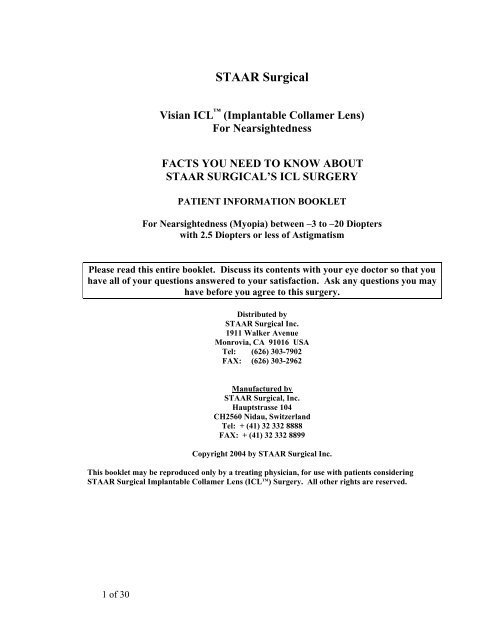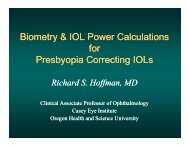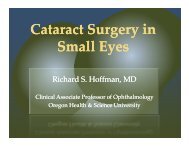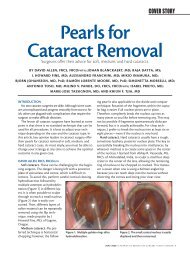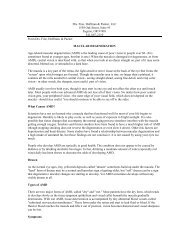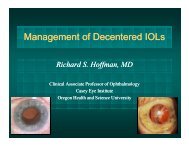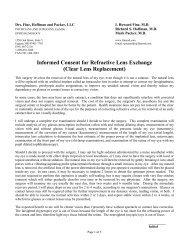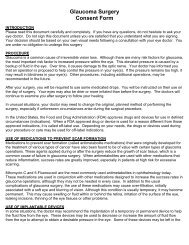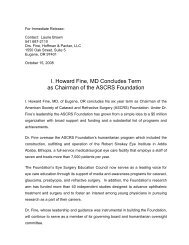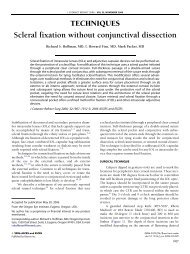ICL Patient Information Booklet
ICL Patient Information Booklet
ICL Patient Information Booklet
Create successful ePaper yourself
Turn your PDF publications into a flip-book with our unique Google optimized e-Paper software.
1 of 30<br />
STAAR Surgical<br />
Visian <strong>ICL</strong> (Implantable Collamer Lens)<br />
For Nearsightedness<br />
FACTS YOU NEED TO KNOW ABOUT<br />
STAAR SURGICAL’S <strong>ICL</strong> SURGERY<br />
PATIENT INFORMATION BOOKLET<br />
For Nearsightedness (Myopia) between –3 to –20 Diopters<br />
with 2.5 Diopters or less of Astigmatism<br />
Please read this entire booklet. Discuss its contents with your eye doctor so that you<br />
have all of your questions answered to your satisfaction. Ask any questions you may<br />
have before you agree to this surgery.<br />
Distributed by<br />
STAAR Surgical Inc.<br />
1911 Walker Avenue<br />
Monrovia, CA 91016 USA<br />
Tel: (626) 303-7902<br />
FAX: (626) 303-2962<br />
Manufactured by<br />
STAAR Surgical, Inc.<br />
Hauptstrasse 104<br />
CH2560 Nidau, Switzerland<br />
Tel: + (41) 32 332 8888<br />
FAX: + (41) 32 332 8899<br />
Copyright 2004 by STAAR Surgical Inc.<br />
This booklet may be reproduced only by a treating physician, for use with patients considering<br />
STAAR Surgical Implantable Collamer Lens (<strong>ICL</strong> TM ) Surgery. All other rights are reserved.
2 of 30<br />
This page left blank intentionally.
3 of 30<br />
TABLE OF CONTENTS<br />
1. Introduction.............................................................................................................. 5<br />
2. How Does Implantable Collamer Lens Correct Nearsightedness? ..................... 5<br />
3. What Are The Benefits of <strong>ICL</strong> For Nearsightedness?.......................................... 8<br />
4. What Are The Risks of <strong>ICL</strong> For Nearsightedness? ............................................ 11<br />
5. Alternative Treatments: ........................................................................................ 12<br />
6. Contraindications................................................................................................... 13<br />
7. Warnings................................................................................................................. 13<br />
8. Precautions ............................................................................................................. 14<br />
9 Are You A Good Candidate For <strong>ICL</strong> For Nearsightedness Surgery?.............. 15<br />
10. What Should You Expect During <strong>ICL</strong> Surgery?................................................ 16<br />
11. Questions To Ask Your Doctor............................................................................. 18<br />
12 Self-Test .................................................................................................................. 20<br />
13 Summary of Important <strong>Information</strong>.................................................................... 20<br />
14. Glossary .................................................................................................................. 22<br />
15. <strong>Patient</strong> Assistance <strong>Information</strong>............................................................................. 29
4 of 30<br />
This page left blank intentionally.
1.0 INTRODUC TION<br />
The purpose of this booklet is to provide you with information on Implantable<br />
Collamer Lens (<strong>ICL</strong>TM ) surgery for nearsightedness (myopia). Please read this entire<br />
booklet carefully. See the “Glossary” (Section 14) for an explanation of words shown<br />
in italics. Discuss your questions with a doctor trained in <strong>ICL</strong> surgery. You need to<br />
understand the benefits and risks of this surgery before making a decision to have this<br />
procedure.<br />
You may have nearsightedness if you have trouble seeing objects clearly when they<br />
are far away. Nearsightedness, which is also called myopia, is a type of condition<br />
that causes blurred vision. Glasses, contact lenses or eye surgery can correct<br />
nearsightedness and help you see distant objects more clearly.<br />
Your eyeglass prescription is the usual way to tell how nearsighted you are. Your<br />
doctor will use your eyeglass prescription with a thorough eye examination to<br />
determine if you are a candidate for <strong>ICL</strong> surgery. Discuss with your doctor whether<br />
you are a good candidate for <strong>ICL</strong> surgery.<br />
<strong>ICL</strong> surgery is permanent as long as the <strong>ICL</strong> stays in your eye. The <strong>ICL</strong> can be<br />
removed or replaced at a future date. However, residual effect of <strong>ICL</strong> on your eye<br />
after it is removed or replaced, is not known.<br />
2.0 HOW DOES IMPLANTABLE COLLAMER LENS CORRECT<br />
NEARSIGHTEDNESS?<br />
You see objects because your eye focuses light into images. Your eye works like a<br />
camera. The camera lens focuses light to form clear images onto film. Both the<br />
cornea and lens in the eye focus light onto the back surface of the eye, called the<br />
retina. Figure 1 shows that distant vision is clear when light focuses correctly.<br />
5 of 30
6 of 30<br />
DIAGRAM 1: NORMAL EYE<br />
Light focuses on the retina.<br />
Vision is clear.<br />
Nearsightedness is a type of focusing error that results in blurry distant vision. Light<br />
from a distant object focuses in front of the retina, rather than on the retina. Diagram 2<br />
shows that distance vision is blurry when light focuses incorrectly in a nearsighted eye.<br />
DIAGRAM 2: NEARSIGHTED EYE<br />
Light focuses in front of the retina.<br />
Vision is blurry.
Wearing glasses and contact lenses help your eye focus light properly on the retina.<br />
The <strong>ICL</strong> is placed entirely within the posterior chamber (back chamber of the eye)<br />
directly behind the iris and in front of the anterior capsule (front surface) of the<br />
crystalline lens (lens in eye). When correctly positioned, the <strong>ICL</strong> functions to focus light<br />
properly on the retina.<br />
Diagram 3 shows that distant vision is clearer after <strong>ICL</strong> surgery.<br />
7 of 30<br />
DIAGRAM 3: CORRECTION OF VISION AFTER <strong>ICL</strong> SURGERY<br />
Light focuses on the retina after surgery.<br />
Vision is clearer.<br />
EYE AFTER TREATMENT<br />
Light<br />
Entering Eye<br />
Cornea<br />
<strong>ICL</strong><br />
Lens<br />
Retina<br />
The <strong>ICL</strong> is made from a soft plastic and collagen-based material with a design similar<br />
to existing intraocular lenses currently used to correct vision after cataract surgery.<br />
The <strong>ICL</strong> is placed through a small incision in your eye, in front of your existing<br />
crystalline lens in your eye to improve your nearsightedness.<br />
The <strong>ICL</strong> is designed for the correction of moderate to high nearsightedness. It is not<br />
intended to correct any astigmatism you may or may not have. Astigmatism as seen<br />
below is a focusing error of the eye that results in blurred vision. In eye with
astigmatism, cornea is more curved in some directions than others. This causes light rays<br />
to focus at different points inside the eye. Therefore, some parts of objects appear clearer<br />
than other parts.<br />
8 of 30<br />
DIAGRAM 4: NEARSIGHTED and ASTIGMATIC EYE<br />
3.0 WHAT ARE THE BENEFITS OF <strong>ICL</strong> FOR NEARSIGHTEDNESS?<br />
<strong>ICL</strong> surgery has been documented to safely and effectively correct<br />
nearsightedness between –3 diopters (D) to –15 diopters (D), and partially correct<br />
nearsightness up to 20 diopters in eyes with up to 2.5 diopters (D) of astigmatism<br />
If you have nearsightedness within these ranges, <strong>ICL</strong> surgery may improve your distance<br />
vision without eyeglasses or contact lenses.<br />
Clinical Study to Evaluate Risks and Benefits of <strong>ICL</strong>:<br />
A clinical study was conducted to evaluate the benefits and risks of <strong>ICL</strong> Surgery. The<br />
study included 526 eyes of 294 patients to determine benefits and risks. The study results<br />
are discussed below and in “What are the Risks of <strong>ICL</strong> for Nearsightedness?”<br />
(Section 4).
Description of Study <strong>Patient</strong> Group:<br />
9 of 30<br />
Most patients were Caucasian. <strong>Patient</strong>s in the study ranged in age from 21 to 45<br />
years of age and over half of the patients were female.<br />
Nearsightedness before surgery ranged between –3.00D and –20.00D. The<br />
average was –10.06D.<br />
Visual Acuity without Glasses after Surgery:<br />
Visual acuity measures the sharpness of vision using a letter chart. In most states<br />
in the U.S. 20/40 or better vision is required to drive a car without glasses or<br />
contact lenses. Three years after insertion of the <strong>ICL</strong>, 94.7% of eyes in the <strong>ICL</strong><br />
study saw 20/40 or better without glasses or contact lenses.<br />
Visual Acuity* by Preoperative Myopia<br />
Lens Group Exam Interval 20/20 or Better 20/40 or Better<br />
Study <strong>Patient</strong>s<br />
Myopia Subgroup<br />
-7 D<br />
> -7 D to -10 D<br />
> -10 D to -15 D<br />
> -15 D<br />
1 Year<br />
2 Year<br />
3 Year<br />
1 Year<br />
2 Year<br />
3 Year<br />
1 Year<br />
2 Year<br />
3 Year<br />
1 Year<br />
2 Year<br />
3 Year<br />
1 Year<br />
2 Year<br />
3 Year<br />
65.4%<br />
59.6%<br />
59.3%<br />
76.3%<br />
70.3%<br />
72.4%<br />
70.0%<br />
64.3%<br />
62.7%<br />
43.3%<br />
37.5%<br />
37.5%<br />
NA%**<br />
NA%**<br />
NA%**<br />
96.7%<br />
93.4%<br />
94.7%<br />
98.8%<br />
97.3%<br />
98.3%<br />
96.0%<br />
94.9%<br />
92.8%<br />
93.7%<br />
95.0%<br />
93.8%<br />
NA%**<br />
NA%**<br />
NA%**<br />
*Eyes with Preoperative Vision with glasses 20/20 or Better and Targeted for Complete Correction<br />
** No Eyes > 15 D group with this Preoperative Vision or Targeted Correction<br />
In the clinical study of the <strong>ICL</strong>, vision without glasses improved for all eyes<br />
except in those eyes with the most extreme amount of nearsightedness that the
strongest <strong>ICL</strong> could not completely correct and 1 case that developed a retinal<br />
detachment where the uncorrected vision remained unchanged. Some people still<br />
needed glasses or contact lenses after surgery to view distant objects .<br />
<strong>Patient</strong> Satisfaction after <strong>ICL</strong> Surgery:<br />
<strong>Patient</strong>s were asked to report their satisfaction with the <strong>ICL</strong> procedure. Three years after<br />
<strong>ICL</strong> surgery, 92.1% of patients were very/extremely satisfied and 7.3% were<br />
moderately/fairly satisfied with their vision. Only 0.6% of cases were unsatisfied.<br />
Quality of Vision after <strong>ICL</strong> Surgery:<br />
Quality of vision reported by patients as very good/excellent improved from 55% before<br />
the <strong>ICL</strong> to 77% 3 years after the <strong>ICL</strong> procedure. <strong>Patient</strong>s reporting poor/very poor vision<br />
dropped in half at 3 years (5.8%) compared to before the <strong>ICL</strong> (11.6%)<br />
<strong>Patient</strong>s were asked on a questionnaire to report on the following symptoms before and 3<br />
years after the <strong>ICL</strong> procedure. More patients rated the following symptoms absent or<br />
mild at 3 years compared to before the <strong>ICL</strong>: glare, night vision difficulties and night<br />
driving difficulties. Halos and double vision percentages were similar before the <strong>ICL</strong> and<br />
at 3 years.<br />
The higher the level of nearsightedness before the <strong>ICL</strong> procedure, the more frequent and<br />
more severe these symptoms were reported both before and after the <strong>ICL</strong> procedure.<br />
10 of 30<br />
Subjective <strong>Patient</strong> Symptoms- Compared to Pre-op<br />
<strong>Patient</strong> Symptom<br />
Improved<br />
at 3 Years<br />
No Change<br />
at 3 years<br />
Worsened<br />
at 3 Years<br />
Glare 12.0% 78.3% 9.7%<br />
Halos 9.1%% 79.4% 11.4%<br />
Double Vision 1.1%% 97.2% 1.7%<br />
Night Vision 12%% 76.0% 12.0%<br />
Night Driving Difficulties 13.7% 76.1% 10.1%
4.0 WHAT ARE THE RISKS OF <strong>ICL</strong> FOR NEARSIGHTEDNESS?<br />
Implantation of <strong>ICL</strong> is a surgical procedure, and as such, carries potentially<br />
serious risks. Please review this brochure and discuss the risks with your<br />
ophthalmologists.<br />
First Week after <strong>ICL</strong> Surgery: complications reported included: <strong>ICL</strong> removal<br />
and reinsertions (2.5%), shallowness of the front chamber of the eye (0.4%), need<br />
for peripheral iridectomy (0.2%), temporary corneal swelling (edema,11.4%) and<br />
transient inflammation in the eye or iritis (19.5%).<br />
Complications After 1st Week: increase in astigmatism (0.4%), loss of best<br />
corrected vision (1.9%), clouding of the crystalline lens (cataract,1.4%), loss of<br />
cells from the back surface of the cornea responsible for the cornea remaining<br />
clear (endothelial cell loss, 8.9% at 3 years), increase in eye pressure (0.4%), iris<br />
prolapse (0.2%), cloudy areas on the crystalline lens that may or may not cause<br />
patient symptoms (crystalline lens opacities, 2.7%), macular hemorrhage (0.2%),<br />
retinal detachment (0.6%), secondary <strong>ICL</strong> related surgeries (replacements,<br />
repositionings, removals, removals with cataract extraction, 3.1%), subretinal<br />
hemorrhage (0.2%), too much or too little nearsightedness correction (2% off by<br />
more than 2 D), and additional YAG iridotomy necessary (3.2%).<br />
Only 2 eyes (0.5%) lost > 2 lines of best corrected vision (with glasses) compared<br />
to 6.5% of eyes that gained > 2 lines of visual acuity with glasses. Of note, only<br />
6.5% of eyes lost 1 line of best corrected visual acuity while 38% of eyes gained 1<br />
line.<br />
Potential Complications are not limited to those reported during the clinical study.<br />
The following represent potential complications/adverse events reported in<br />
conjunction with refractive surgery in general: conjunctival irritation, acute<br />
11 of 30
corneal swelling, persistent corneal swelling, endophthalmitis (total eye<br />
infection), significant glare and/or halos around lights, hyphema (blood in the<br />
eye), hypopyon (pus in the eye), eye infection, <strong>ICL</strong> dislocation, macular edema,<br />
non-reactive pupil, pupillary block glaucoma, severe inflammation of the eye,<br />
iritis, uveitis, vitreous loss and corneal transplant.<br />
Overall, the higher the amount of nearsightedness before the <strong>ICL</strong>, the higher the<br />
incidence of complications/risks after <strong>ICL</strong> surgery.<br />
5.0 ALTERNAT IVE TREATMENTS<br />
The types of eye surgeries that are available to correct nearsightedness are Radial<br />
Keratotomy (RK), Photorefractive Keratectomy (PRK), Laser Assisted in situ<br />
Keratomileusis (LASIK) and Phakic Intraocular Lens surgery. The Implantable<br />
Collamer Lens is a type of phakic intraocular lens. These surgeries may not meet<br />
the vision requirements for some careers, such as military service.<br />
Eye surgeries can be categorized by those that change the shape of the front<br />
surface of your cornea, which is the clear layer at the front of your eye (including<br />
RK, PRK and LASIK) and intraocular lens surgery that involves the insertion of a<br />
lens within the eye.<br />
RK uses a scalpel to make fine cuts in the cornea.<br />
PRK and LASIK use a laser to reshape the cornea. For LASIK, an instrument<br />
called a microkeratome first cuts a thin flap of tissue from the front of your<br />
cornea. This corneal flap is folded back and the laser removes tissue under the<br />
flap to change the shape of the front surface of your eye (cornea). Then the flap<br />
is put back in place for the eye to heal.<br />
12 of 30
6.0 CONTRAIN DICATIONS<br />
You should NOT have <strong>ICL</strong> surgery if you:<br />
7.0 WARNINGS<br />
13 of 30<br />
Have a narrow anterior chamber angle as determined by a special<br />
examination by your eye doctor, or if your doctor determines that the shape of<br />
your eye is not adequate to fit the <strong>ICL</strong> (anterior chamber depth less than 3<br />
mm)<br />
Are pregnant or nursing<br />
Do not meet the minimum endothelial cell density for your age at the time of<br />
implantation as determined by your eye doctor<br />
Two iridotomies (holes in the extreme outer edge of the colored portion of the<br />
eye) must be performed 90º apart using a yttrium aluminum garnet (YAG) laser at<br />
between 2 to 3 weeks before implantation of the <strong>ICL</strong>.<br />
The long-term effects on the corneal endothelium have not been established. You<br />
should be aware of potential risk of corneal edema (swelling), possibly requiring<br />
corneal transplantation. Periodic checks of your endothelium are recommended<br />
to monitor the long-term health of the cornea<br />
The long-term rate of cataract formation (decrease clarity of your natural<br />
crystalline lens) secondary to implantation / removal and/or replacement of the<br />
<strong>ICL</strong> are unknown.<br />
The potential of the lens to alter the pressure in your eye and the long-term risks<br />
of glaucoma, peripheral anterior synechiae and pigment dispersion are unknown.
8.0 PRECAUTI ONS<br />
1. <strong>Patient</strong>s with higher amounts of nearsightedness had worse results with lower<br />
effectiveness and higher risk of complications.<br />
2. The effect of pupil size on visual symptoms is not known.<br />
3. The relationship between the <strong>ICL</strong> and future lens opacities and retinal detachment<br />
is undetermined.<br />
4. There currently is a lack of long-term data to assess cataract formation and<br />
cataract progression following removal and/or replacement of the lens.<br />
5. The effectiveness of ultraviolet absorbing lenses in reducing the incidence of<br />
retinal disorders has not been established.<br />
6. The safety and effectiveness of the <strong>ICL</strong> for the correction of moderate to high<br />
nearsightedness has NOT been established in patients:<br />
with unstable or worsening nearsightedness<br />
with history or clinical signs of iritis/uveitis<br />
with diabetic retinopathy<br />
with glaucoma<br />
14 of 30<br />
with history of previous eye surgery<br />
with serious (life-threatening) non-ophthalmic disease<br />
with progressive sight-threatening disease other than nearsightedness<br />
with a diagnosis of ocular hypertension(high eye pressure)<br />
with insulin-dependent diabetes<br />
with pseudoexfoliation<br />
with pigment dispersion<br />
with greater than 20 D of nearsightedness \ ;greater than 2.5 D of astigmatism
9.0 ARE YOU A GOOD CANDIDATE FOR <strong>ICL</strong> FOR NEARSIGHTEDNESS<br />
SURGERY?<br />
If you are considering <strong>ICL</strong> surgery for nearsightedness you must:<br />
be between the ages of 21 and 45<br />
have between –3D and –20D of nearsightedness and no more than 2.5D of<br />
astigmatism<br />
understand that the <strong>ICL</strong> is indicated for the correction of nearsightedness between<br />
–3D and ≤ -15D and the reduction of nearsightedness between > -15D and –20D<br />
have an anterior chamber depth of 3.0 millimeters or greater<br />
have a minimally acceptable endothelium cell density which will be determined<br />
by your physician<br />
Have a refraction that has been stable for at least 1 year<br />
understand the risks and benefits of <strong>ICL</strong> for nearsightedness surgery compared to<br />
other available treatments for nearsightedness<br />
be able to lie flat on your back<br />
have no known allergies to any of the medications that your physician may<br />
discuss will be used before, during and after your surgery<br />
not be pregnant or nursing<br />
15 of 30
understand that prior to implantation of the <strong>ICL</strong> you will need to undergo YAG<br />
iridotomy 2 to 3 weeks before <strong>ICL</strong> surgery<br />
be willing to sign an Informed Consent Form provided by your doctor.<br />
10.0 WHAT SHO ULD YOU EXPECT DURING <strong>ICL</strong> SURGERY?<br />
Before the Surgery<br />
Before surgery, your doctor needs to determine your complete medical and eye history<br />
and check the health of both your eyes. This exam will determine if your eyes are<br />
healthy and if you are a good candidate for <strong>ICL</strong> surgery. This examination will include a<br />
measurement of the inner layer of your cornea (endothelium).<br />
Tell your doctor if you take any medications, have any eye conditions, have undergone<br />
previous eye surgery, have any medical conditions or have any allergies. Ask your<br />
doctor if you should eat or drink right before the surgery. You should also arrange for<br />
transportation since you must not drive immediately after surgery. Your doctor will<br />
let you know when your vision is good enough to drive again.<br />
Two to Three Weeks before Surgery<br />
Two to three weeks before your <strong>ICL</strong> surgery, your eye doctor will schedule to perform<br />
YAG laser iridotomy to prepare your eye for implantation of the <strong>ICL</strong>. This is necessary to<br />
make sure that the fluid flows properly from the back chamber to the front chamber of the<br />
eye to prevent a buildup of pressure within the eye after <strong>ICL</strong> surgery. The doctor will<br />
usually apply numbing drops to the eye and the make tiny openings in the colored portion<br />
of the eye with a laser beam. Usually this doesn’t affect your ability to drive home after<br />
this procedure but check with your eye doctor.<br />
16 of 30
After the iridotomy procedure, your eye doctor will prescribe eye drops for you to use. It<br />
is important that you follow-up all medication instructions. Your physician will instruct<br />
you to discontinue the use of these medications before the day of surgery.<br />
The Day of Surgery<br />
The day of surgery, your eye doctor will place eye drops in your eye to dilate (enlarge)<br />
the pupil in your eye.<br />
Once your pupil is fully dilated, your eye doctor will put numbing eye drops in your eye<br />
and/or use a shot of numbing medication and ask you to lie on your back on the treatment<br />
table/chair in the treatment room. Your eye doctor may discuss alternative<br />
anesthetic/sedation options with you before surgery.<br />
A small incision is made into your cornea and the <strong>ICL</strong> is inserted and positioned in its<br />
proper position in the eye as illustrated at the beginning of this booklet. The entire<br />
procedure will usually take approximately 20 to 30 minutes or less.<br />
After the surgery is complete, your doctor will place some eye drops/ointment in your<br />
eye. For your eye protection and comfort, your doctor may apply a patch or shield over<br />
your eye. The procedure is painless because of the numbing medication. It is important<br />
that you do not drive yourself home and make arrangements before the day of<br />
surgery for transportation home.<br />
The First Days after Surgery<br />
Your physician will need to see you the day after surgery for a check up which will<br />
include monitoring the pressure in your eye.<br />
You may be sensitive to light and have a feeling that something is in your eye.<br />
Sunglasses may make you more comfortable. Also, your eye may hurt. Your doctor can<br />
17 of 30
prescribe pain medication to make you more comfortable during the first few days after<br />
the surgery. If you experience severe pain in the eye, please contact your doctor<br />
immediately. You will needs to use antibiotics and anti-inflammatory eye medications<br />
(eye drops/ointments) in the first week.<br />
IMPORTANT: Use the eye medications as directed by your eye doctor. (Your results<br />
may depend upon your following your doctor’s instructions).<br />
DO NOT rub your eyes especially for the first 3 to 5 days. If you notice any sudden<br />
decrease in your vision, you should contact your doctor immediately.<br />
Long Term Care: In a small number of cases <strong>ICL</strong> replacement and/or removal may<br />
become necessary. After <strong>ICL</strong> surgery it is important that you follow your physician’s<br />
recommendations for eye care and follow-up visits.<br />
11.0 QUESTION S TO ASK YOUR DOCTOR<br />
You may want to ask the following questions to help you decide if <strong>ICL</strong> surgery for<br />
nearsightedness is right for you:<br />
18 of 30<br />
What are my other options to correct my nearsightedness?<br />
Will I have to limit my activities after surgery and for how long?<br />
What are the benefits of <strong>ICL</strong> surgery for my amount of nearsightedness?<br />
What vision can I expect in the first few months after surgery?<br />
If <strong>ICL</strong> surgery does not correct my vision, what is the possibility that my<br />
eyeglasses would need to be stronger than before? Could my need for
19 of 30<br />
eyeglasses increase over time? Could I undergo a different type of eye<br />
surgery for the correction of my vision?<br />
How is <strong>ICL</strong> surgery likely to affect my need to wear eyeglasses or contact<br />
lenses as I get older?<br />
Will my eye heal differently, if injured after implantation of the <strong>ICL</strong>?<br />
Should I have <strong>ICL</strong> surgery in my other eye?<br />
How long will I have to wait before I can have surgery in my other eye?<br />
What vision problems might I experience if I have an <strong>ICL</strong> only in 1 eye?<br />
Discuss the cost of surgery and follow-up care needs with your doctor. Most<br />
health insurance policies do not cover eye surgery for the correction of<br />
nearsightedness.
12.0 SELF-TEST<br />
Are You An Informed And Educated <strong>Patient</strong>?<br />
Take the test below to see if you can answer the following questions after reading.<br />
20 of 30<br />
True False<br />
1. <strong>ICL</strong> surgery for nearsightedness is the same as laser<br />
surgery. □ □<br />
2. <strong>ICL</strong> surgery is risk-free. □ □<br />
3. It does not matter if I wear my contact lenses before <strong>ICL</strong><br />
surgery when my doctor told me not to wear them. □ □<br />
4. After the surgery, there is a good chance that I will<br />
depend less on eyeglasses or contact lenses to see<br />
distance objects. □ □<br />
5. There is a risk I may lose some best corrected<br />
vision after <strong>ICL</strong> surgery. □ □<br />
6. It does not matter if I am pregnant or nursing. □ □<br />
7. If my doctor finds that I have narrow chamber angles,<br />
I am still a good candidate for <strong>ICL</strong> surgery. □ □<br />
8. The <strong>ICL</strong> will correct my astigmatism □ □<br />
9. It is important I follow my eye doctor’s specific<br />
instructions concerning medications. □ □<br />
10. My eye doctor does not need to know about my full<br />
medical history (conditions not dealing with the eye) □ □<br />
You can find the answers to Self-Test at the bottom of the page.21<br />
13.0 SUMMARY OF IMPORTANT INFORMATION<br />
<strong>ICL</strong> Surgery provides a permanent correction of your nearsightedness as long as<br />
the <strong>ICL</strong> remains in the eye. The <strong>ICL</strong> may be removed or replaced.
<strong>ICL</strong> surgery does not eliminate the need for reading glasses, even if you have<br />
never worn them before.<br />
Your vision must be stable before <strong>ICL</strong> surgery. You must provide written<br />
evidence that your nearsightedness has changed no more than 0.50 D each year<br />
for at least 1 year.<br />
Pregnant and nursing women should wait until they are not pregnant and not<br />
nursing to have the <strong>ICL</strong> surgery.<br />
<strong>ICL</strong> surgery has some risks. Please read and understand this entire booklet before<br />
you agree to the surgery. The sections on Benefits and Risks are especially<br />
important to read carefully.<br />
Some other options to correct nearsightedness include glasses, contact lenses, RK,<br />
PRK and LASIK.<br />
Before considering <strong>ICL</strong> surgery you should:<br />
21 of 30<br />
a. have a complete eye examination.<br />
b. talk with at least one eye care professional about <strong>ICL</strong> surgery, especially<br />
the potential benefits, risks, and complications. You should discuss the<br />
time needed for healing after surgery.<br />
Certain eye diseases, eye conditions, previous eye surgery, systemic medical<br />
conditions may have an impact on the results after <strong>ICL</strong> surgery. It is important<br />
that you provide your eye doctor with your complete medical history so your eye<br />
doctor may determine if you are a good candidate for the <strong>ICL</strong> for correction of<br />
nearsightedness.
The <strong>ICL</strong> is intended to improve your vision However, because you are a<br />
nearsighted patient you should consult with your eye doctor on a regular basis<br />
(i.e., once a year) to verify the overall health of your eye.<br />
Answers to Self-Test Questions:<br />
1. F 6. F<br />
2. F 7. F<br />
3. F 8. F<br />
4. T 9. T<br />
5. T 10. F<br />
14.0 GLOSSARY<br />
This section summarizes important terms used in this information booklet or that your<br />
eye doctor may discuss with you. Please discuss any related questions with your doctor.<br />
Acute Corneal Decompensation: A sudden opacification (clouding) of the usually clear<br />
front surface of the eye (cornea).<br />
Anterior Capsule: The front surface of the crystalline lens. It is a thin layer of skin<br />
totally surrounding the lens much like the skin of a grape.<br />
Anterior Chamber: Front chamber of the eye; anterior chamber depth is the thickness<br />
of the chamber<br />
Antibiotic Medication: A drug used to treat or prevent infection. Your doctor may<br />
prescribe this medication after <strong>ICL</strong> surgery.<br />
Anti-inflammatory Medication: A drug that reduces inflammation or the body’s<br />
reaction to injury or disease. Any eye surgery can cause inflammation. Your doctor may<br />
prescribe the medication after <strong>ICL</strong> surgery.<br />
22 of 30
Astigmatic Keratotomy: A type of eye surgery that changes the shape of the front<br />
surface of the eye by making a special pattern of cuts in the cornea to correct<br />
astigmatism.<br />
Astigmatism: A focusing error that results in blurred distant and/or near vision. The<br />
cornea is more curved in some directions than others, and causes light rays to focus at<br />
different points inside the eye. Parts of objects appear clearer than other parts.<br />
Cataract: Opacity, or clouding, of the crystalline lens inside the eye that can blur vision.<br />
Collagen: A gel-like supporting substance found in the cornea, skin and other<br />
connective tissue of the body.<br />
Implantable Collamer Lens (<strong>ICL</strong>): A collagen based contact lens which is implanted<br />
permanently in the rear chamber of the eye immediately in front of the crystalline lens in<br />
order to correct nearsightedness. The <strong>ICL</strong> can be replaced or removed.<br />
Conjunctival Irritation: A reddening of the observable, white portion of the eyeball<br />
and inner eyelid.<br />
Contraindications: Any special conditions that result in the treatment not being<br />
recommended.<br />
Contrast Sensitivity: A measure of the ability of the eye to detect small lightness<br />
differences between objects and the background in daylight and in dim light. For<br />
example, black lines on a gray background are easier to see than gray lines on a gray<br />
background. Objects in daylight are also easier to see than in dim light. Contrast<br />
sensitivity is a way to determine how well patients can see in poor contrast conditions<br />
such as very dim light, rain, snow and fog.<br />
23 of 30
Cornea: The clear front layer of the eye. Surgery such as PRK, LASIK and RK<br />
reshapes the front surface of the cornea to improve distant vision.<br />
Corneal Edema: Abnormal fluid build-up/swelling in the cornea. The condition is<br />
usually temporary after surgery with no significant effect on vision. Persistent corneal<br />
edema may be indefinite.<br />
Corneal Flap: A thin slice of tissue on the surface of the cornea made with a<br />
microkeratome at the beginning of a LASIK procedure. This flap is folded back before<br />
the laser shapes the inner layer of the cornea.<br />
Corneal Transplant: Removal and replacement of cornea<br />
Crystalline Lens: A structure inside the eye that helps to focus light onto the back<br />
surface (retina) of the eye.<br />
Diabetic Retinopathy: Damage to the back surface of the eye responsible for sensing<br />
light due to diabetes.<br />
Diopter: A unit of focusing power, used to describe the amount of nearsightedness and<br />
astigmatism of an eye. Abbreviated as “D”.<br />
Double Vision: Seeing multiple images of the object being looked at.<br />
Endophthalmitis: Severe infection or inflammation of the entire eyeball.<br />
Endothelium: Inner layer of the cornea.<br />
Endothelial Cell Loss: Loss of cells in the endothelium. Endothelial cells are essential<br />
in keeping the cornea clear and are essential for maintenance of good vision.<br />
24 of 30
Excimer Laser: A type of laser used in LASIK and PRK to remove tissue from the<br />
cornea.<br />
Glare: A harsh or uncomfortable bright light. Glare symptoms are usually caused by a<br />
distortion of light that would otherwise be tolerable without the distortion.<br />
Glaucoma: An eye disease usually associated with high eye pressure. Glaucoma<br />
damages the optic nerve of the eye and usually causes a progressive loss of vision.<br />
Halos: Circular flares or rings of light that may appear around a headlight or other<br />
lighted object. This symptom may occur after surgery.<br />
Hyphema: Blood in the anterior chamber of the eye.<br />
Hypopyon: Plus in the front chamber of the eye.<br />
<strong>ICL</strong>: Implantable Collamer Lens (see Device Description Section of this <strong>Booklet</strong>)<br />
Intraocular Lenses: A lens that is placed in the eye after extraction of a cataract and<br />
removal of the crystalline lens.<br />
Intraocular Pressure (IOP): Pressure measurement monitored in your eye.<br />
Iris: Colored part of the eye.<br />
Iris Prolapse: A movement of the colored portion of the eye through a surgical wound<br />
to a position outside the eye.<br />
Iritis/Uveitis: Inflammation in the anterior chamber or other portion of the eye.<br />
25 of 30
Laser Assisted In-Situ Keratomileusis (LASIK): A type of eye surgery that uses a<br />
microkeratome and a laser to improve vision. The microkeratome creates a thin, hinged<br />
flap of tissue on the cornea which is then folded back. The laser shapes the tissue under<br />
the flap and the flap is put back on the eye so the tissue heals.<br />
Lens: Natural crystalline lens in the eye which helps focus light properly into the back of<br />
the eye.<br />
Lens Opacities: A cloudiness of the crystalline lens.<br />
Lens Dislocation: A movement of the lens to an improper position.<br />
Macular Edema: Swelling in the area responsible for fine (reading) vision on the back<br />
surface of the eye (retina).<br />
Macular Hemorrhage: Bleeding in the area responsible for fine (reading) vision on the<br />
back surface of the eye (retina).<br />
Manifest Refraction Spherical Equivalent (MRSE): A routine examination of the eye<br />
to evaluate the amount of refractive error (i.e., amount of nearsightedness; amount of<br />
astigmatism). <strong>Information</strong> used to prepare eyeglass/contact lens prescriptions.<br />
Microkeratome: A surgical instrument used in LASIK to cut a thin flap of tissue from<br />
the front surface of the eye (cornea) before the laser treatment is applied.<br />
Myopia: A focusing error that results in blurrier vision at distance than near. Myopia is<br />
also called nearsightedness.<br />
Narrow Anterior Chamber Angle: A decrease in the size of the front chamber of the<br />
eye which could block the flow of fluid from inside to outside of the eye resulting in a<br />
raised eye pressure (glaucoma).<br />
26 of 30
Nearsightedness: A focusing error that results in blurrier vision at distance than near.<br />
Nearsightedness is also called myopia.<br />
Non-reactive Pupil: A condition where the colored portion of the eye does not get<br />
larger or smaller when light is shined in the eye or removed.<br />
Ocular Hypertension: Increased eye pressure.<br />
Peripheral Iridectomy: A small hole placed at the outer edge of the colored portion of<br />
the eye.<br />
Phakic Intraocular Lens: Placement of a manmade lens in a patient who still has their<br />
natural crystalline lens.<br />
Photorefractive Keratectomy (PRK): A type of eye surgery that uses an excimer laser<br />
to reshape the front surface of the eye is to improve vision. After the epithelium<br />
(outermost layer) of the cornea is first scraped away, the laser removes tissue from the<br />
exposed surface. After the surgery, the epithelium grows back.<br />
Peripheral Anterior Synechiae: Scar tissue at the outer edges of the front chamber of<br />
the eye.<br />
Pigment Dispersion: An abnormal release of pigment particles from cells in the eye that<br />
could get trapped in the fluid filtering mechanism (trabecular meshwork) possibly<br />
causing an increase in pressure in the eye (glaucoma).<br />
Posterior Chamber: Back or rear chamber of the eye.<br />
Pseudoexfoliation: A condition where flakes of material can come off the surface of the<br />
crystalline lens and block the drainage of fluid from the inside to the outside of the eye.<br />
27 of 30
Pupil: The black part of the eye; fluctuates in size allowing varying degrees of light into<br />
the eye.<br />
Pupillary Block: The inability of fluid to flow from the back chamber of the eye to the<br />
front chamber frequently blocking drainage of fluid out of the eye and raising the<br />
pressure in the eye (glaucoma).<br />
Radial Keratotomy (RK): A type of eye surgery that changes the shape of the front<br />
surface of the eye by making a special pattern of cuts in the cornea to correct<br />
nearsightedness.<br />
Retina: The layer of nerve tissue at the back of the eye that captures images, similar to<br />
film in a camera, and sends information about these images to the brain. Light must be<br />
focused correctly on the retina to form clear images.<br />
Retinal Detachment: Separation of the retina from the rest of the back surface of the<br />
eyeball.<br />
Shallow Anterior Chamber: A flattening of the front chamber of the eye.<br />
Subretinal Hemorrhage: Bleeding under the retina (see retina above).<br />
Visual Acuity: A measure of the sharpness of vision using a letter chart. Best Corrected<br />
Visual Acuity (best vision with eyeglasses or contact lenses). Uncorrected Visual Acuity<br />
(best vision without eyeglasses or contact lenses).<br />
Vitreous Loss: The loss of a clear gel like material from the farthest back chamber of<br />
the eyeball out of the eye during a surgical procedure.<br />
28 of 30
YAG Laser: (Yttrium Aluminum Garnet) Laser Iridotomy: Production of a small<br />
hole in the colored portion of the eye using a laser beam.<br />
15.0 PATIENT A SSISTANCE INFORMATION<br />
To be completed by you or your Primary Eye Care Professional as a reference.<br />
Primary Eye Care Professional<br />
<strong>ICL</strong> Doctor<br />
29 of 30<br />
Name:<br />
Address:<br />
Phone:<br />
Name:<br />
Address:<br />
Phone:<br />
Treatment Location<br />
Name:<br />
Address:<br />
Phone:
Implantable Collamer Lens (<strong>ICL</strong>) Manufacturer:<br />
U.S. Distributor:<br />
30 of 30<br />
STAAR Surgical, Inc.<br />
Hauptstrasse 104<br />
CH2560 Nidau, Switzerland<br />
Tel: + (41) 32 332 8888<br />
FAX: + (41) 32 332 8899<br />
STAAR Surgical Inc.<br />
Regulatory Department<br />
1911 Walker Avenue<br />
Monrovia, CA 91016 USA<br />
Tel: (626) 303-7902<br />
FAX: (626) 303-2962


